Hung-Shin Lee
Leveraging Retrieval-Augmented Generation for Culturally Inclusive Hakka Chatbots: Design Insights and User Perceptions
Oct 21, 2024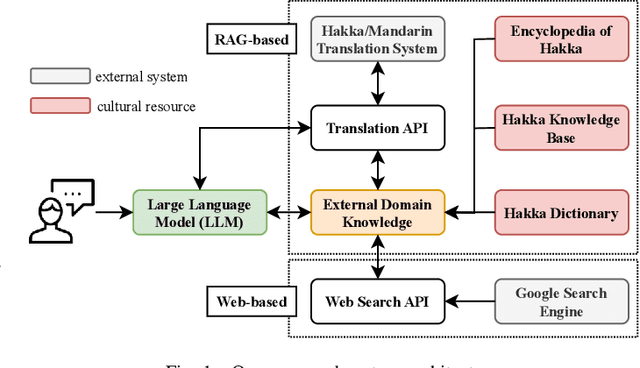
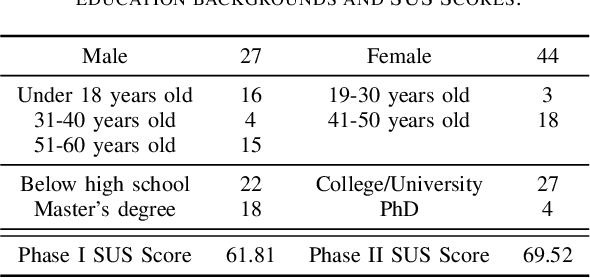
Abstract:In an era where cultural preservation is increasingly intertwined with technological innovation, this study introduces a groundbreaking approach to promoting and safeguarding the rich heritage of Taiwanese Hakka culture through the development of a Retrieval-Augmented Generation (RAG)-enhanced chatbot. Traditional large language models (LLMs), while powerful, often fall short in delivering accurate and contextually rich responses, particularly in culturally specific domains. By integrating external databases with generative AI models, RAG technology bridges this gap, empowering chatbots to not only provide precise answers but also resonate deeply with the cultural nuances that are crucial for authentic interactions. This study delves into the intricate process of augmenting the chatbot's knowledge base with targeted cultural data, specifically curated to reflect the unique aspects of Hakka traditions, language, and practices. Through dynamic information retrieval, the RAG-enhanced chatbot becomes a versatile tool capable of handling complex inquiries that demand an in-depth understanding of Hakka cultural context. This is particularly significant in an age where digital platforms often dilute cultural identities, making the role of culturally aware AI systems more critical than ever. System usability studies conducted as part of our research reveal a marked improvement in both user satisfaction and engagement, highlighting the chatbot's effectiveness in fostering a deeper connection with Hakka culture. The feedback underscores the potential of RAG technology to not only enhance user experience but also to serve as a vital instrument in the broader mission of ethnic mainstreaming and cultural celebration.
Exploring the Impact of Data Quantity on ASR in Extremely Low-resource Languages
Sep 13, 2024Abstract:This study investigates the efficacy of data augmentation techniques for low-resource automatic speech recognition (ASR), focusing on two endangered Austronesian languages, Amis and Seediq. Recognizing the potential of self-supervised learning (SSL) in low-resource settings, we explore the impact of data volume on the continued pre-training of SSL models. We propose a novel data-selection scheme leveraging a multilingual corpus to augment the limited target language data. This scheme utilizes a language classifier to extract utterance embeddings and employs one-class classifiers to identify utterances phonetically and phonologically proximate to the target languages. Utterances are ranked and selected based on their decision scores, ensuring the inclusion of highly relevant data in the SSL-ASR pipeline. Our experimental results demonstrate the effectiveness of this approach, yielding substantial improvements in ASR performance for both Amis and Seediq. These findings underscore the feasibility and promise of data augmentation through cross-lingual transfer learning for low-resource language ASR.
Effective Noise-aware Data Simulation for Domain-adaptive Speech Enhancement Leveraging Dynamic Stochastic Perturbation
Sep 03, 2024Abstract:Cross-domain speech enhancement (SE) is often faced with severe challenges due to the scarcity of noise and background information in an unseen target domain, leading to a mismatch between training and test conditions. This study puts forward a novel data simulation method to address this issue, leveraging noise-extractive techniques and generative adversarial networks (GANs) with only limited target noisy speech data. Notably, our method employs a noise encoder to extract noise embeddings from target-domain data. These embeddings aptly guide the generator to synthesize utterances acoustically fitted to the target domain while authentically preserving the phonetic content of the input clean speech. Furthermore, we introduce the notion of dynamic stochastic perturbation, which can inject controlled perturbations into the noise embeddings during inference, thereby enabling the model to generalize well to unseen noise conditions. Experiments on the VoiceBank-DEMAND benchmark dataset demonstrate that our domain-adaptive SE method outperforms an existing strong baseline based on data simulation.
VoxHakka: A Dialectally Diverse Multi-speaker Text-to-Speech System for Taiwanese Hakka
Sep 03, 2024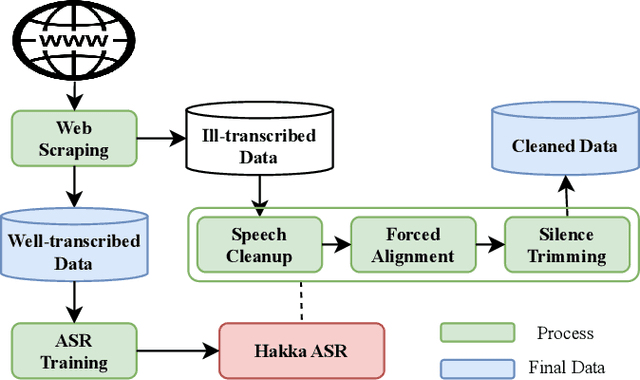

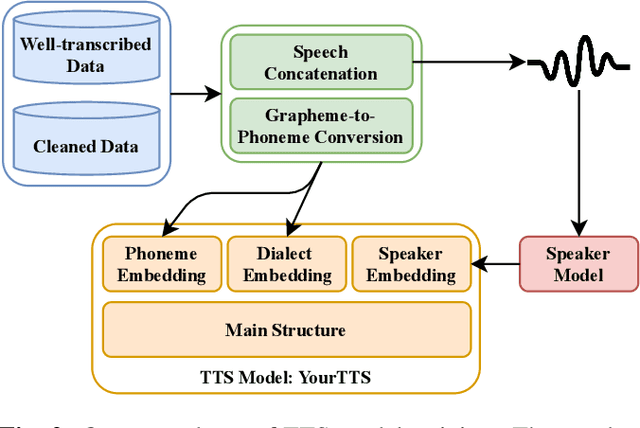

Abstract:This paper introduces VoxHakka, a text-to-speech (TTS) system designed for Taiwanese Hakka, a critically under-resourced language spoken in Taiwan. Leveraging the YourTTS framework, VoxHakka achieves high naturalness and accuracy and low real-time factor in speech synthesis while supporting six distinct Hakka dialects. This is achieved by training the model with dialect-specific data, allowing for the generation of speaker-aware Hakka speech. To address the scarcity of publicly available Hakka speech corpora, we employed a cost-effective approach utilizing a web scraping pipeline coupled with automatic speech recognition (ASR)-based data cleaning techniques. This process ensured the acquisition of a high-quality, multi-speaker, multi-dialect dataset suitable for TTS training. Subjective listening tests conducted using comparative mean opinion scores (CMOS) demonstrate that VoxHakka significantly outperforms existing publicly available Hakka TTS systems in terms of pronunciation accuracy, tone correctness, and overall naturalness. This work represents a significant advancement in Hakka language technology and provides a valuable resource for language preservation and revitalization efforts.
Benchmarking Cognitive Domains for LLMs: Insights from Taiwanese Hakka Culture
Sep 03, 2024Abstract:This study introduces a comprehensive benchmark designed to evaluate the performance of large language models (LLMs) in understanding and processing cultural knowledge, with a specific focus on Hakka culture as a case study. Leveraging Bloom's Taxonomy, the study develops a multi-dimensional framework that systematically assesses LLMs across six cognitive domains: Remembering, Understanding, Applying, Analyzing, Evaluating, and Creating. This benchmark extends beyond traditional single-dimensional evaluations by providing a deeper analysis of LLMs' abilities to handle culturally specific content, ranging from basic recall of facts to higher-order cognitive tasks such as creative synthesis. Additionally, the study integrates Retrieval-Augmented Generation (RAG) technology to address the challenges of minority cultural knowledge representation in LLMs, demonstrating how RAG enhances the models' performance by dynamically incorporating relevant external information. The results highlight the effectiveness of RAG in improving accuracy across all cognitive domains, particularly in tasks requiring precise retrieval and application of cultural knowledge. However, the findings also reveal the limitations of RAG in creative tasks, underscoring the need for further optimization. This benchmark provides a robust tool for evaluating and comparing LLMs in culturally diverse contexts, offering valuable insights for future research and development in AI-driven cultural knowledge preservation and dissemination.
The North System for Formosa Speech Recognition Challenge 2023
Oct 06, 2023Abstract:This report provides a concise overview of the proposed North system, which aims to achieve automatic word/syllable recognition for Taiwanese Hakka (Sixian). The report outlines three key components of the system: the acquisition, composition, and utilization of the training data; the architecture of the model; and the hardware specifications and operational statistics. The demonstration of the system has been made public at https://asrvm.iis.sinica.edu.tw/hakka_sixian.
CasNet: Investigating Channel Robustness for Speech Separation
Oct 27, 2022Abstract:Recording channel mismatch between training and testing conditions has been shown to be a serious problem for speech separation. This situation greatly reduces the separation performance, and cannot meet the requirement of daily use. In this study, inheriting the use of our previously constructed TAT-2mix corpus, we address the channel mismatch problem by proposing a channel-aware audio separation network (CasNet), a deep learning framework for end-to-end time-domain speech separation. CasNet is implemented on top of TasNet. Channel embedding (characterizing channel information in a mixture of multiple utterances) generated by Channel Encoder is introduced into the separation module by the FiLM technique. Through two training strategies, we explore two roles that channel embedding may play: 1) a real-life noise disturbance, making the model more robust, or 2) a guide, instructing the separation model to retain the desired channel information. Experimental results on TAT-2mix show that CasNet trained with both training strategies outperforms the TasNet baseline, which does not use channel embeddings.
A Teacher-student Framework for Unsupervised Speech Enhancement Using Noise Remixing Training and Two-stage Inference
Oct 27, 2022



Abstract:The lack of clean speech is a practical challenge to the development of speech enhancement systems, which means that the training of neural network models must be done in an unsupervised manner, and there is an inevitable mismatch between their training criterion and evaluation metric. In response to this unfavorable situation, we propose a teacher-student training strategy that does not require any subjective/objective speech quality metrics as learning reference by improving the previously proposed noisy-target training (NyTT). Because homogeneity between in-domain noise and extraneous noise is the key to the effectiveness of NyTT, we train various student models by remixing the teacher model's estimated speech and noise for clean-target training or raw noisy speech and the teacher model's estimated noise for noisy-target training. We use the NyTT model as the initial teacher model. Experimental results show that our proposed method outperforms several baselines, especially with two-stage inference, where clean speech is derived successively through the bootstrap model and the final student model.
Filter-based Discriminative Autoencoders for Children Speech Recognition
Apr 01, 2022



Abstract:Children speech recognition is indispensable but challenging due to the diversity of children's speech. In this paper, we propose a filter-based discriminative autoencoder for acoustic modeling. To filter out the influence of various speaker types and pitches, auxiliary information of the speaker and pitch features is input into the encoder together with the acoustic features to generate phonetic embeddings. In the training phase, the decoder uses the auxiliary information and the phonetic embedding extracted by the encoder to reconstruct the input acoustic features. The autoencoder is trained by simultaneously minimizing the ASR loss and feature reconstruction error. The framework can make the phonetic embedding purer, resulting in more accurate senone (triphone-state) scores. Evaluated on the test set of the CMU Kids corpus, our system achieves a 7.8% relative WER reduction compared to the baseline system. In the domain adaptation experiment, our system also outperforms the baseline system on the British-accent PF-STAR task.
Generation of Speaker Representations Using Heterogeneous Training Batch Assembly
Mar 30, 2022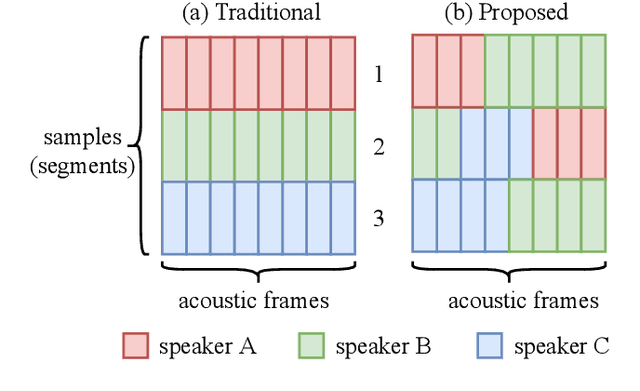
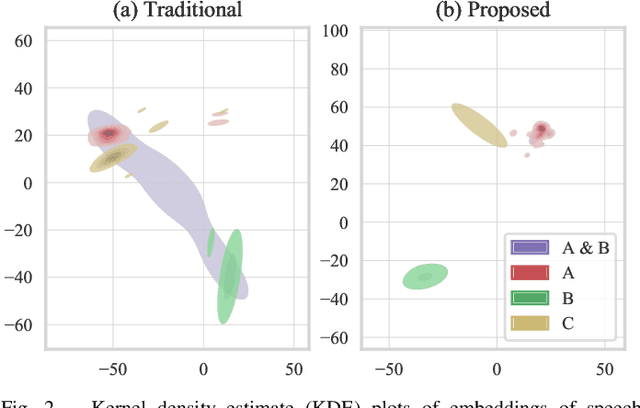
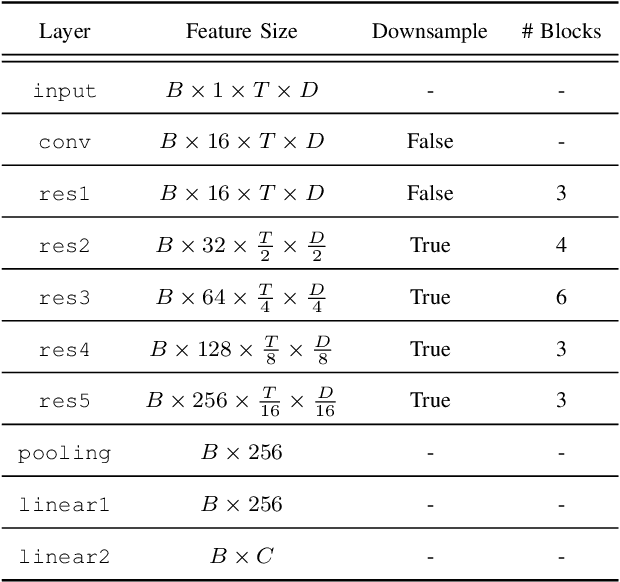
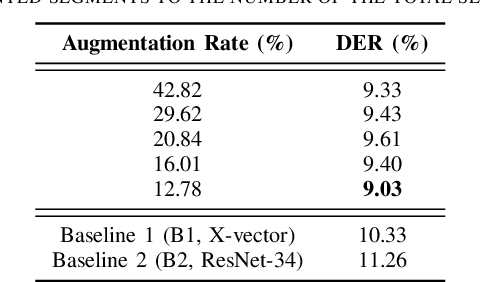
Abstract:In traditional speaker diarization systems, a well-trained speaker model is a key component to extract representations from consecutive and partially overlapping segments in a long speech session. To be more consistent with the back-end segmentation and clustering, we propose a new CNN-based speaker modeling scheme, which takes into account the heterogeneity of the speakers in each training segment and batch. We randomly and synthetically augment the training data into a set of segments, each of which contains more than one speaker and some overlapping parts. A soft label is imposed on each segment based on its speaker occupation ratio, and the standard cross entropy loss is implemented in model training. In this way, the speaker model should have the ability to generate a geometrically meaningful embedding for each multi-speaker segment. Experimental results show that our system is superior to the baseline system using x-vectors in two speaker diarization tasks. In the CALLHOME task trained on the NIST SRE and Switchboard datasets, our system achieves a relative reduction of 12.93% in DER. In Track 2 of CHiME-6, our system provides 13.24%, 12.60%, and 5.65% relative reductions in DER, JER, and WER, respectively.
 Add to Chrome
Add to Chrome Add to Firefox
Add to Firefox Add to Edge
Add to Edge